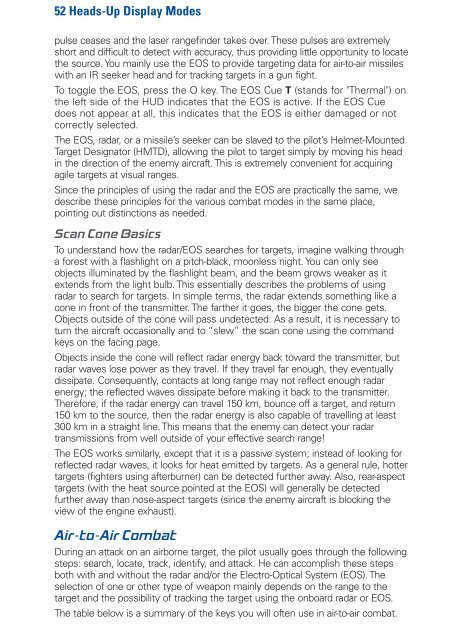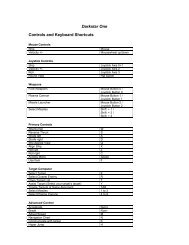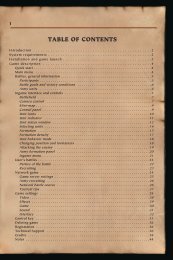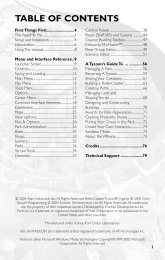Heads-Up Display Modes 35 - Metaboli
Heads-Up Display Modes 35 - Metaboli
Heads-Up Display Modes 35 - Metaboli
You also want an ePaper? Increase the reach of your titles
YUMPU automatically turns print PDFs into web optimized ePapers that Google loves.
52 <strong>Heads</strong>-<strong>Up</strong> <strong>Display</strong> <strong>Modes</strong><br />
pulse ceases and the laser rangefinder takes over. These pulses are extremely<br />
short and difficult to detect with accuracy, thus providing little opportunity to locate<br />
the source. You mainly use the EOS to provide targeting data for air-to-air missiles<br />
with an IR seeker head and for tracking targets in a gun fight.<br />
To toggle the EOS, press the O key. The EOS Cue N (stands for "Thermal") on<br />
the left side of the HUD indicates that the EOS is active. If the EOS Cue<br />
does not appear at all, this indicates that the EOS is either damaged or not<br />
correctly selected.<br />
The EOS, radar, or a missile’s seeker can be slaved to the pilot’s Helmet-Mounted<br />
Target Designator (HMTD), allowing the pilot to target simply by moving his head<br />
in the direction of the enemy aircraft. This is extremely convenient for acquiring<br />
agile targets at visual ranges.<br />
Since the principles of using the radar and the EOS are practically the same, we<br />
describe these principles for the various combat modes in the same place,<br />
pointing out distinctions as needed.<br />
Scan Cone Basics<br />
To understand how the radar/EOS searches for targets, imagine walking through<br />
a forest with a flashlight on a pitch-black, moonless night. You can only see<br />
objects illuminated by the flashlight beam, and the beam grows weaker as it<br />
extends from the light bulb. This essentially describes the problems of using<br />
radar to search for targets. In simple terms, the radar extends something like a<br />
cone in front of the transmitter. The farther it goes, the bigger the cone gets.<br />
Objects outside of the cone will pass undetected. As a result, it is necessary to<br />
turn the aircraft occasionally and to “slew” the scan cone using the command<br />
keys on the facing page.<br />
Objects inside the cone will reflect radar energy back toward the transmitter, but<br />
radar waves lose power as they travel. If they travel far enough, they eventually<br />
dissipate. Consequently, contacts at long range may not reflect enough radar<br />
energy; the reflected waves dissipate before making it back to the transmitter.<br />
Therefore, if the radar energy can travel 150 km, bounce off a target, and return<br />
150 km to the source, then the radar energy is also capable of travelling at least<br />
300 km in a straight line. This means that the enemy can detect your radar<br />
transmissions from well outside of your effective search range!<br />
The EOS works similarly, except that it is a passive system; instead of looking for<br />
reflected radar waves, it looks for heat emitted by targets. As a general rule, hotter<br />
targets (fighters using afterburner) can be detected further away. Also, rear-aspect<br />
targets (with the heat source pointed at the EOS) will generally be detected<br />
further away than nose-aspect targets (since the enemy aircraft is blocking the<br />
view of the engine exhaust).<br />
Air-to-Air Combat<br />
During an attack on an airborne target, the pilot usually goes through the following<br />
steps: search, locate, track, identify, and attack. He can accomplish these steps<br />
both with and without the radar and/or the Electro-Optical System (EOS). The<br />
selection of one or other type of weapon mainly depends on the range to the<br />
target and the possibility of tracking the target using the onboard radar or EOS.<br />
The table below is a summary of the keys you will often use in air-to-air combat.















